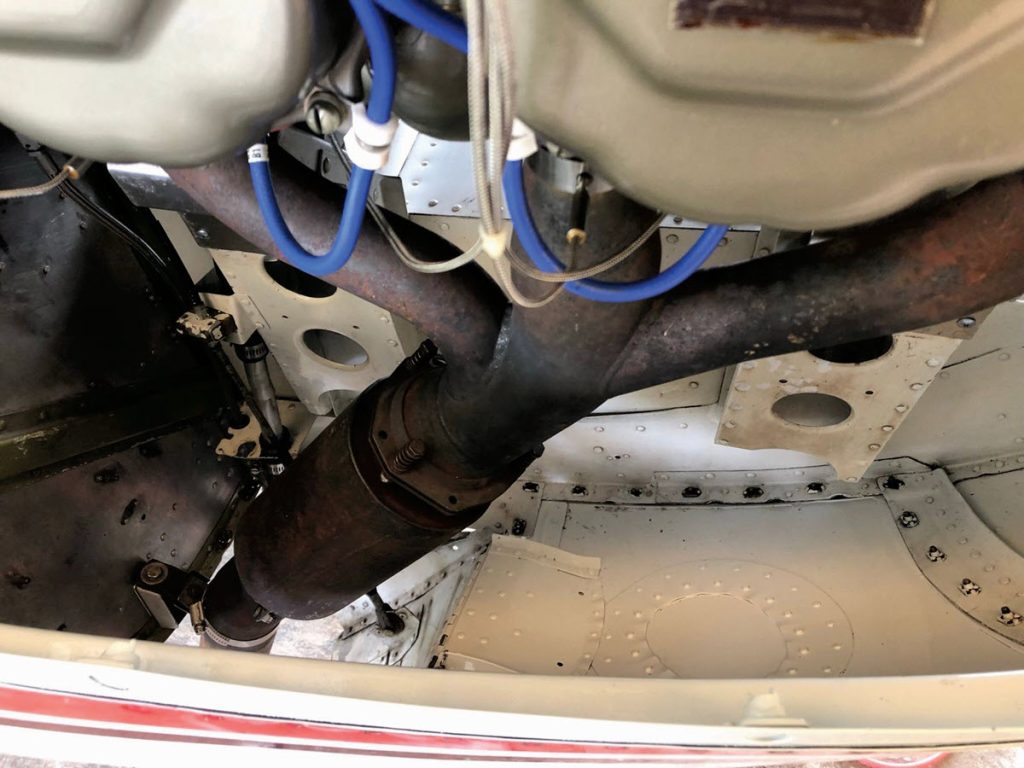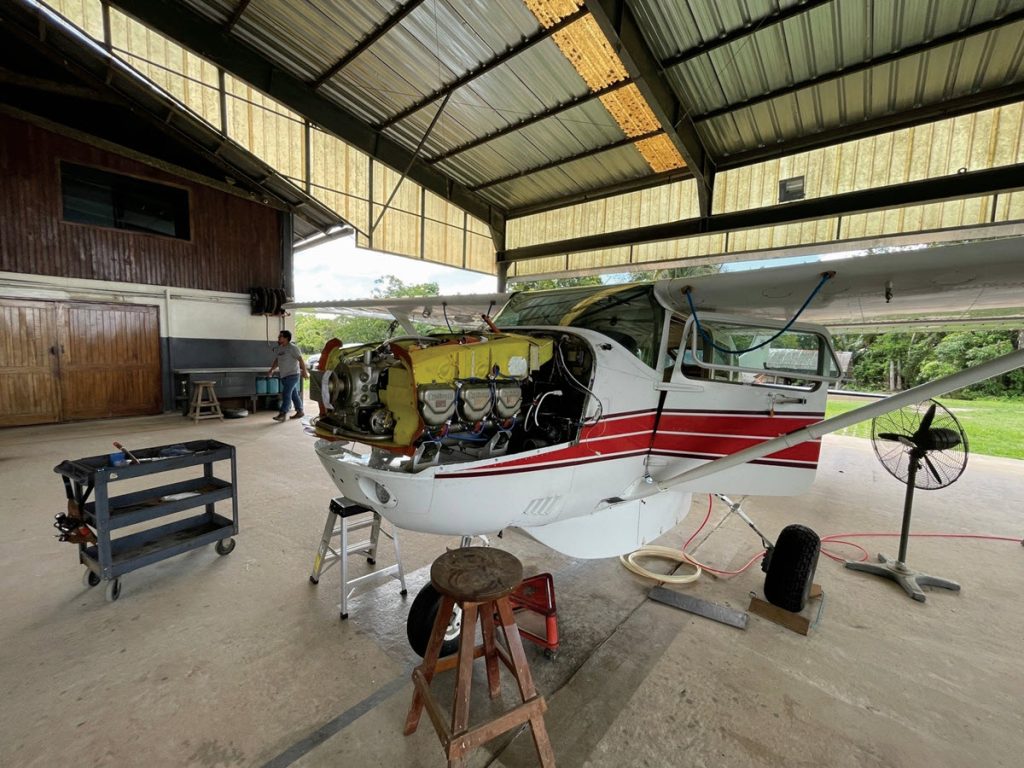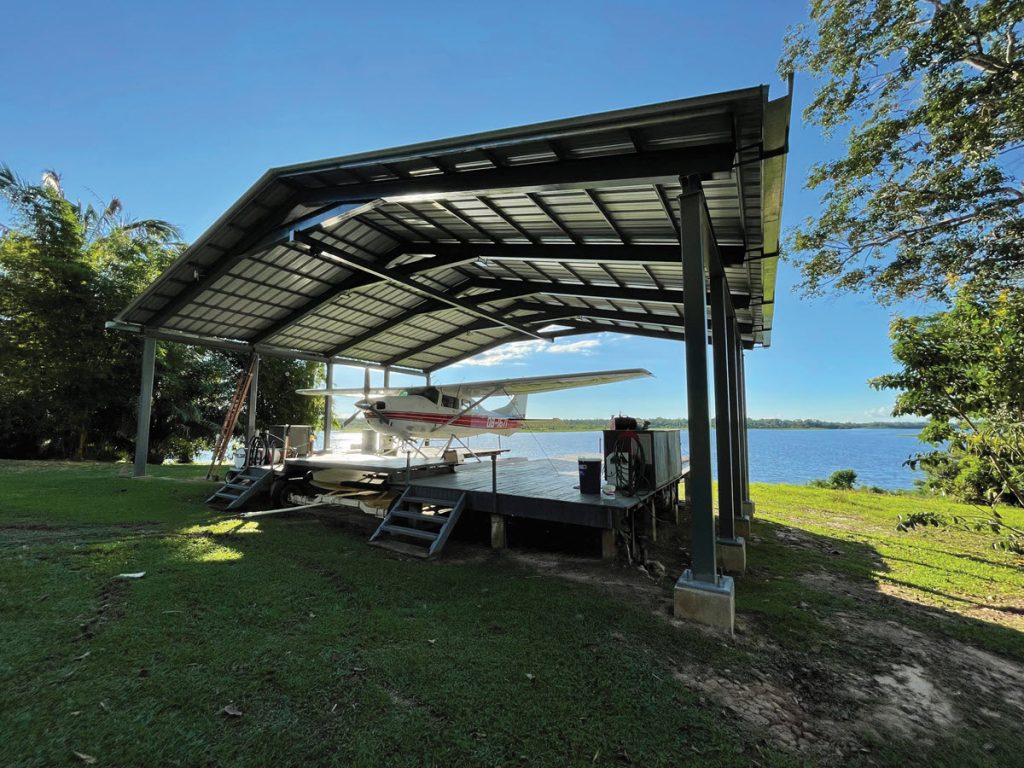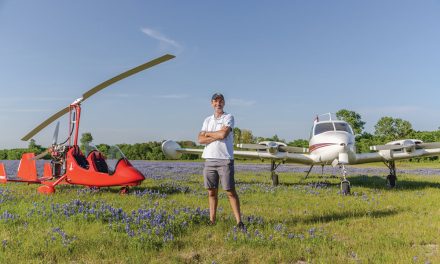
By Donna Jones
Are modifications worth it? One group that thinks they are — South America Mission (SAMAIR) — is located in Pucallpa, Peru. The 206/T206 aircraft they operate are a vital part of their organization.
An Unfortunate Incident
Since 1992, OB-1467 — a Cessna U206 on floats — had been serving the missionaries of SAMAIR and the tribal communities of the jungles of Peru with service into and out of some of the most remote parts of the Amazon jungle. But on Nov. 8, 2020, around 2 p.m., a strong storm rolled in from the east. One of the wind gusts picked up the roof over the floatplane and slammed it down, crushing the airplane and damaging it beyond repair. There was other significant storm damage around the aviation base, but none as catastrophic as the destruction of the floatplane and hangar.
Without their floatplane, SAMAIR lost the ability to provide critical transportation to some very hard-to-reach places. Considering that they had the only missionary floatplane operating in Peru, response time to emergency medical requests doubled. For SAMAIR to continue their critical float operations, they repaired the floats from the damaged aircraft (OB-1467) and installed them on one of the naturally aspirated Cessna U206s, OB-1671, which is the plane that still remains on floats for their operation today. All three SAMAIR aircraft had the additional reinforcement and longer tail stingers needed so any of their 206s could go on floats. The remaining plane, Cessna TU206, OB-2211 — still with the turbocharger and on wheels — was available to meet the needs of the land plane requests. For 2021, SAMAIR flew just those two aircraft instead of three.
Only a few months after the storm and loss of their original OB-1467 floatplane, they learned of a TU206 at Jungle Aviation and Radio Service (JAARS), another missionary organization based in North Carolina. This aircraft had already been deturboed under the Davis Aviation STC to a normally aspirated IO-550F. The aircraft was being outfitted for Cameroon, but due to the inability to obtain avgas in Africa, JAARS decided they no longer wanted this aircraft and offered to sell it to SAMAIR. The maintenance and modifications SAMAIR had requested on this T206 aircraft (N9691Z) were completed Labor Day 2021. The plane was flown to Peru at the end of November 2021, approximately one year and three weeks after the loss of their floatplane. This gave them three aircraft again.
You can view part of the flight of N9691Z from JAARS to the SAMAIR base in Peru in a four-minute YouTube video at www.youtube.com/watch?v=CeB1osX2pi4 Some very interesting flying!
After flying three aircraft again for most of 2022, SAMAIR decided in October to deturbo their TU206 (OB-2211) to a normally aspirated IO-550F as well. Fortunately, some of the parts were salvaged from OB-1467 to help make this change. Both land planes (OB-2211 and N9691Z) — TU206 deturbo models — now have the same approximate empty weight, allowing for interchangeable usable loads for the operators on any land plane flight. Their standard U206 (OB-1671) is still on floats and fulfilling the needs of their float operation.
SAMAIR is the perfect example of the need for modifications and continued product support. Their operation could not support the funding for a new Cessna or wait for one without years of planning. They were able to obtain a TU206 that fit their needs with the installation of a normally aspirated IO-550 engine, as well as to install a normally aspirated IO-550 engine on their own TU206 once TBO was reached. This gave them a “common” fleet of planes and enabled them to continue their much-needed missionary work in Peru with three active 206/T206 planes.



Why Deturbo?
In most cases, a turbocharged aircraft doesn’t produce additional horsepower. Rather, the turbocharged system tricks the engine into believing it’s at sea level, enabling it to keep manifold pressure to the higher altitudes. While at takeoff, it may gain initial horsepower, but generally the power drops after five minutes to continuous power at a lower rpm. The real advantage is that you can improve your service ceiling from the standard 206 at 14,800 feet (or 15,700 feet for the 206H) to 26,300 feet (27,000 feet for the TU206H). When operating in areas with a higher density altitude, the Turbo 206 may be the only way to clear obstacles and maintain the manifold pressure power needed to operate in those areas.
The IO-550 upgrade for the Cessna T206 aircraft is designed for the customer who has a turbocharged aircraft but really doesn’t use it that way. The conversion “deturbos” the aircraft, meaning that the IO-550F normally aspirated engine is installed and the induction parts and exhaust system are changed out. Cowl flap doors are changed or modified as well. On the TSIO-520 C and M, the actual turbocharger, wastegate, etc. are airframe items and not part of the engine. When all of that is removed, that reduces weight by 40 pounds. So the plane flies like a standard 206 with more power. At normal altitudes, the IO-550 will perform as well — and in some cases better — than the TSIO-520 being removed. You just can’t fly at 24,000 feet any longer. The biggest advantage is that it reduces the expensive maintenance.


Engine Modifications and Refurbishments
For the newer 206/T206 aircraft, there aren’t many options to upgrade, as these aircraft have the newer items installed as standard or optional already approved in the original build of the aircraft. As time passes, newer products, including propellers and engine changes, have become available. Companies like Bonaire Aviation (now Davis Aviation), go through the long and tedious process to get those upgrades approved. The idea is to bring the aircraft current while improving the aircraft performance.
The company provides the proper engineering, testing, and other pertinent data to the FAA for approval for whatever is being changed. This approval allows the company to provide the updated product to the owners of older Cessna aircraft. Once that process is complete, a Supplemental Type Certificate (STC) is issued. The STC holder issues a one-time license, giving permission to install the STC conversion for that individual aircraft. In many cases, the parts for the upgrade are supplied with the STC paperwork.
STCs can be difficult and take a long time to be approved with conformity inspections, structure analysis, noise testing, and other FAA requirements. In the early 1990s, I worked with Bonaire Aviation during the STC process for the deturbo modification for the T206 series aircraft. It took more than three years to get the STC completed and approved by the FAA.
Many STCs are still available for the 206/T206 series aircraft. Davis Aviation is among a handful of companies offering engine and/or propeller upgrades for both the 206/T206 aircraft. Hartzell, MT Propeller, and even McCauley have made newer design propeller changes available via STC for the older 206/T206 series aircraft to replace the obsolete McCauley models originally installed.



VERSATILITY OF CESSNA 206/T206 MODELS
Of all the single-engine Cessna aircraft rated for six passengers or less, the 206/T206 series is probably the most versatile. From 1964 to 1986, Cessna manufactured a variety of versions, including the 206, P206, U206, T206, TP206, and TU206 models. The 206H and TU206H models have been manufactured from 1998 to the present.
Old or new, the 206/T206 series aircraft are the workhorses of the Cessna aircraft fleet. From 1965 to 1970, Cessna manufactured a P206 series and TP206 series (turbocharged engine version). These P206/TP206 models had the passenger door rather than the rear cargo door of the U206/TU206 series manufactured from 1964 through 1986. They were still a workhorse but were designed for comfort and speed to meet the needs of any operator.
The P206 models were designed like the 182, except they featured a fuel-injected higher horsepower engine, higher gross weight, wider body, and more passenger capacity, among other design improvements. The TP206 was designed similarly, but with the turbocharged engine to allow a better service ceiling. The P206/TP206 aircraft combined accounted for 700 Cessna manufactured aircraft. Production stopped in 1970 for the P206 and TP206 models. Many of the older Cessna 206/T206 series aircraft (all models) are still flying today throughout the world. That goes to show the popularity of these aircraft.
When new aircraft production was started again, Cessna picked up with the 206H and TU206H series. About 1,500 206H and T206H model aircraft were manufactured from 1998 until 2015. Since 2015, they have been manufactured by Textron Aviation.
It’s difficult to determine how many of the normally aspirated 206 and Turbo 206 were manufactured. The 206/T206 series are in the same type certificate, so when a new aircraft was ordered, then or now, you could order either version — turbocharged or normally aspirated — as a base model and then add any extras. They would assign the next serial number to it when it was manufactured. The serial numbers for both planes are the same series.
Known as the station wagon of the Cessna models, the U206 and TU206 versions are heavy haulers on wheels or floats. They’re designed to get you where you’re going and haul what you need. The 1964 to 1986 models allow a 3,300- to 3,600-pound gross weight, which gives a lot of useful load, including five passengers and a pilot.
The early model 206, U206A, and P206 through P206E aircraft were equipped with the IO-520A engine (285 hp). In 1967, the U206B series started with the IO-520F engine (300 hp on takeoff at 2,850 rpm/285 hp continuous at 2,700 rpm). The turbo version allowed a 285 hp version (TSIO-520C) and in the late 1970s upgraded to the TSIO-520M, which delivered 310 hp on takeoff and 285 hp continuous. The IO-520F for the normally aspirated models and the TSIO-520M for the turbo models completed the line until production stopped in 1986. Continental Motors and McCauley two- or three-blade propellers were original equipment.
Currently, Textron Aviation, formerly Cessna Aircraft, is contracted with Lycoming and McCauley to continue manufacturing the same models using their engines and propellers.
Engine and Propeller STCs Available for the 206/T206 Series
The following is a summary of various engine and propeller upgrades available for the 206/T206 series. Some information is limited, so if you’re interested in any of these options, contact the STC holder directly.
- Hartzell and MT Propellers offer propeller-only STCs for use with existing engines. Also, some of their models can be used as a second STC upgrade when an engine upgrade is made. That means if a certain STC number is installed on a plane, the propeller-only STC is applicable with the modified plane. This covers the original equipment model, plus any of those planes that have an engine upgrade referenced in the prop-only STC.
- Vitatoe offers various Hartzell models via a prop-only STC for original equipment models and models that have engines changes. The STC is specific to the model, so it’s important to determine if your aircraft is included. Vitatoe offers a crossflow-modified engine for 206 models also with a propeller change.
- McCauley propeller changes may be via a “when exhausted use” STC or a propeller-only STC, depending on the model aircraft. These propeller options are for use with the existing engine.
- Davis Aviation offers the IO-550F engine (300 hp continuous) and various propeller options for all T206 models (TP206 models through the TU206G). The turbocharged engine is removed and replaced with the normally aspirated IO-550F engine. For the 206 (1964 206 SN 0001 and on, including the P206 models through the U206G), the IO-550F replaces the IO-520 A or F engine. In most cases, the propeller is changed also. Other prop-only STCs call out these STCs to offer more propeller options with the 206 or the T206 deturbo installation.
- Ram Aircraft offers a conversion from the earlier TSIO-520C engine (285 hp) to the TSIO-520M engine (310 hp takeoff/285 hp continuous) with a propeller change. This makes the early model T206 models like the TU206G models. The aircraft still has a turbocharged engine.
- Soloy Turbines offers a 400+ hp turbine conversion with a propeller change. Changes occur from the firewall forward for this upgrade but provide more horsepower than any of the other options. They cover 206 and T206 models.
- Summit Aviation offers the IO-550N tuned-induction upgrade for certain 206/TU206 models (serial numbers 2200 to 7020) with a propeller change. The turbocharged TSIO-520 engine or the IO-520F engine is removed and replaced with a 310 hp normally aspirated engine. The T206 is a deturbo change. The standard 206 power is increased to 310 hp.
- Wipaire offers the IO-550F engine upgrade for certain model 206 aircraft (T206 models not included) with a propeller change.
- Texas Skyways offers the IO-550F engine upgrade for Cessna 206 models (T206 models not included) with a propeller change.
Plan ahead and do your homework before you commit to one of these options. Ask for details in writing so you don’t get any surprises when making a decision.
Donna Jones has worked in aviation for more than 30 years, beginning with Bonaire Aviation and staying with Davis Aviation when they bought the Bonaire 550 product line in 1998. She helped establish over 30 STCs for the single-engine Cessna line, as well as assisted in numerous field approvals and deviations when an STC was not available for a particular installation. Davis Aviation continues with worldwide distribution of the Bonaire 550 engine and propeller upgrade, propeller-only installations, and engine mount modifications. Davis Aviation offers a variety of STC options for Cessna aircraft (180, 182, 185, 188, 206, T206, 207 and T207 models). Contact Davis Aviation at (423) 652-1113 (office), (423) 646-3425 (cell), dasi@charter.net or www.davisaviation.cc





